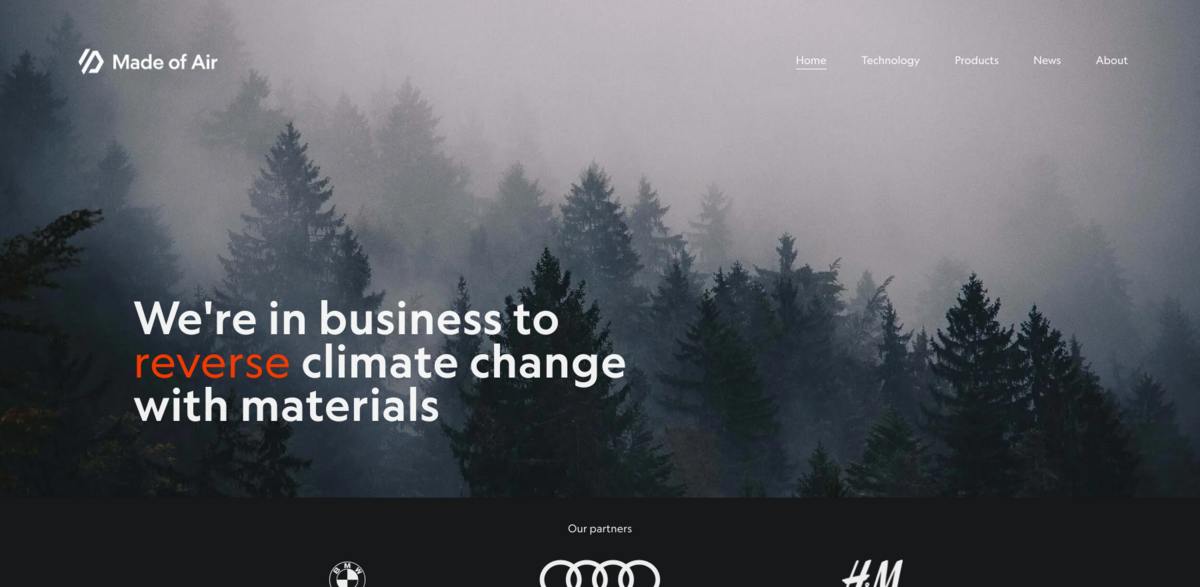What is Made of Air?
Made of Air is on a mission to reverse climate change by transforming CO₂ into innovative building materials. This groundbreaking project focuses on converting atmospheric carbon into solid compounds that can be used in construction and manufacturing. Their unique material is made of 90% atmospheric carbon—a solid form of greenhouse gases—that sequesters 2 tons of CO₂ per ton of material. These compounds can be shaped into facade panels, furniture, interior elements, and automotive products, all designed to significantly lower the carbon footprint of the final product. In fact, Made of Air’s materials contain the highest volume of CO₂ per ton in the construction industry, making them carbon-negative and climate-friendly.
Main Benefits of Made of Air’s Technology
The impact of Made of Air’s technology is impressive. Here are some key figures and facts that highlight its potential:
- Sequesters 2 tons of CO₂ per ton of material produced
- Contains 90% atmospheric carbon, turning greenhouse gases into solid compounds
- Highest volume of CO₂ per ton in the construction industry
- Carbon-negative materials that help reverse climate change
- Materials can be formed into facade panels, furniture, interiors, and automotive parts
- Offers superior global warming potential (GWP), lower weight, and enhanced heat & UV resistance
How the Technology Works
At the core of Made of Air’s innovation is the functionalization of biocarbon into carbon-negative fillers. Biomass waste streams naturally store CO₂ through photosynthesis. Then, through pyrolysis, this CO₂ is converted into near-elemental biogenic carbon. The technology takes this biocarbon and transforms it into functional fillers for composites. These fillers are available as powder, masterbatch, or even ready-made boards, making them versatile for various industrial applications. The more tons of these fillers used, the more CO₂ is effectively removed from the atmosphere—meaning the products themselves act as carbon sinks.
Unique Proprietary Treatments
Made of Air applies a series of proprietary treatments to raw biocarbon, turning it into a high-value, engineered functional filler. This deep-tech process ensures absolute consistency in the additives, making them drop-in ready for bio-composites. The raw char, sourced from underutilized biomass gasification streams, is highly carbon-negative but unusable in its natural state. The proprietary MOA treatment fine-tunes this biocarbon with chemical and surface modifications, creating super-engineered fillers that can be tailored for different polymers and use cases.
Applications and Product Forms
The end products are versatile and designed for real-world use. Made of Air offers their engineered biocarbon fillers in three main forms:
- Filler powder for compounders
- Masterbatch for manufacturers
- Ready-made boards for built-environment applications
These materials behave like mineral fillers but outperform them in many ways—offering better sustainability, lower weight, and improved resistance to heat and UV exposure. This makes them ideal for a wide range of industries, from construction to automotive and interior design.
Project Impact on Sustainable Development Goals (SDGs)
- SDG 9: Industry, Innovation, and Infrastructure – through pioneering material technology
- SDG 11: Sustainable Cities and Communities – by providing climate-friendly building materials
- SDG 12: Responsible Consumption and Production – via sustainable sourcing and manufacturing
- SDG 13: Climate Action – by actively removing CO₂ from the atmosphere
- SDG 15: Life on Land – through the use of biomass waste streams and carbon sequestration
Patents and Innovation Leadership
Made of Air isn’t just creating new materials—they’re breaking new ground in the industry. To date, the project has filed more than five patents, protecting their unique processes and treatments. This commitment to innovation ensures that their solutions remain at the cutting edge of climate-positive material science, offering scalable and impactful ways to decarbonize supply chains and meet ambitious climate goals set by cities and industries worldwide.





















